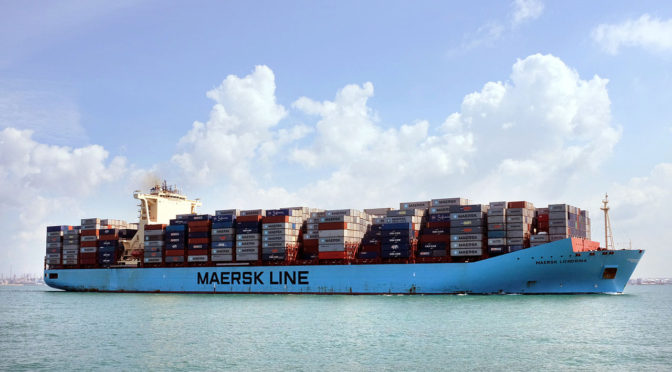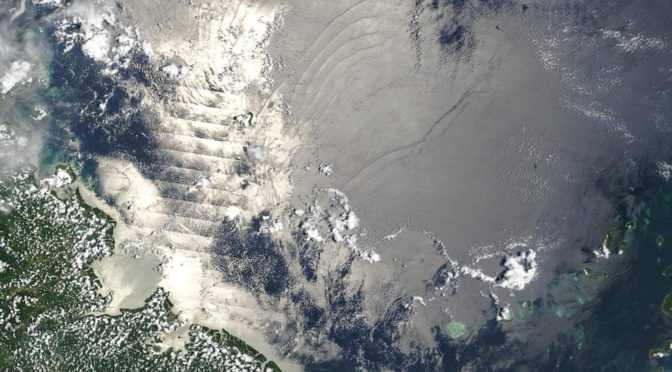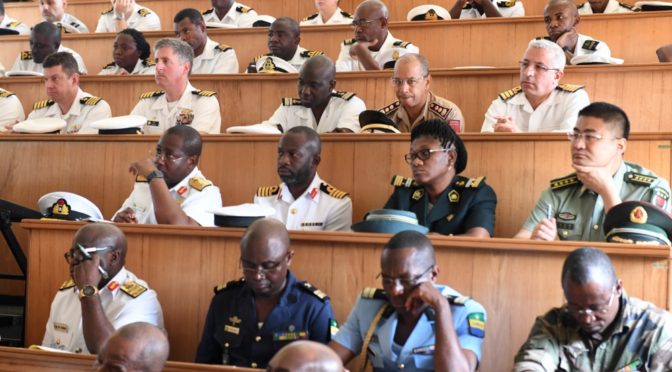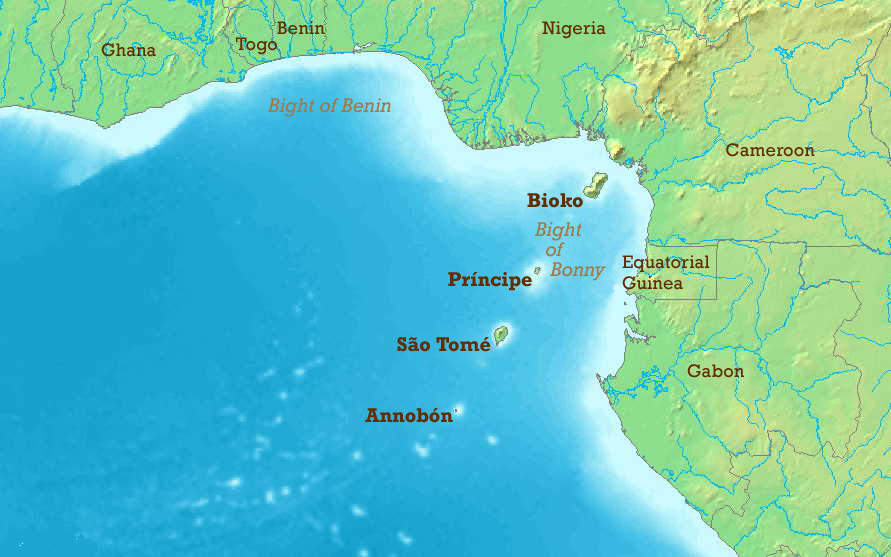By Jessica K. Simonds
Seafarers engage in various security practices while transiting the Straits of Hormuz, Bab Al-Mandeb, the Gulf of Aden, and the broader Indian Ocean. How have these practices developed to identify and communicate emerging maritime threats based on how seafarer feedback has been incorporated within strategies that counter piracy? These developments will be understood by drawing on original interview material from the author’s PhD thesis, which featured interactions with seafarers from all ranks of the merchant navy bridge team as well as senior representatives from the protection and indemnity and traditional maritime insurance world.
Maritime governance is a fluid and dynamic process and is open to active development when responding to threats, new and old, that are prominent hinderances to merchant shipping. The reorientation of this process, from a regime that was constructed to deter Somali-based piracy, is evident in the mechanisms of information sharing and the related dissemination platforms. New threats such as the Houthi rebel insurgency as well as the shift toward identifying unidentified attackers are embedded within literature that has been developed by the conglomerate of industry actors (such as the Best Management Practice series), as well as the experiences of seafarers who have transited the aptly named High Risk Area (HRA) within the last two years.
Attempting to define an approach to the topic of ocean governance is as broad as addressing the web of interactions that underpin terrestrial global governance. The seas are providing a dynamic and volumetric geography featuring many layers, such as the liquidity of the sea with its own natural resources and politics. The ocean landscape also hosts micro-societies, constituting communities of seafarers aboard vessels that represent mobile beacons of sovereignty. Although this seemingly leaves nothing more than tracks in the sea, through the translation of laws and norms ships are where politics happens as global maritime regimes are legitimized through practice.
The shore-based construction of maritime governance encompasses the formal and informal, structured and temporary, state, non-state, industrial, research, and military interactions. International political regimes have been constructed to preserve these layers. Drawing on the seas as a resource that furthers the goals of land-based civilizations, regimes such as the United Nations Convention on the Law of the Sea (UNCLOS) divides maritime territory as corresponsive to these layers. These include access to the seabed, exclusive rights to marine resources such as fishing stocks and oil, and the implementation of structures such as wind turbines, to name a few.
Normative approaches to ocean governance are important because it sets a frame of reference for shore-based entities to consolidate maritime crimes into a recognizable and translatable legal and policy framework. Yet, it also informs daily practice onboard merchant vessels through structures of routine as set out by frameworks such as the International Ship and Port Security (ISPS) Code and the International Safety Management (ISM) Code. In the effort to counter Somali-based piracy and armed robbery from 2009 to the present day, the Head of Marine Underwriting at Lloyd’s Market Association – Neil Roberts – asserts that it involves the construction of a three-legged stool consistent of “naval missions, communication structures …and vessel-based security strategies.”
This framework has been credited with the successful decline in successful hijackings. Naval missions such as the EU’s Naval Force’s (EUNAVFOR) Operation Atlanta and the U.S.-led Combined Maritime Forces (CMF) have patrolled the area since late 2008 (NATO’s Operation Ocean Shield was terminated in December 2016) and have contributed to the deterrence and disruption of piracy, forming one of these legs. Yet the Nautical Institute asserts that it would require “83 helicopter-equipped vessels to provide an effective one-hour response, when most vessels are only able to request help with a 10-minute warning,” reflecting the interdependence of the three-legged approach. Therefore, the practical performance of working with the sea and making critical decisions at the frontline of deterring piracy becomes the responsibility of the seafarers and sailors themselves, who must transform their vessels into a site of defense. This is embedded into practice through implementing practices into the Ship’s Security Plan (SSP) and resonate through seafarer experiences of crossing the “imagined line in the sea” where danger may lie ahead.
Transforming the vessel into a counter-piracy asset is based on the master’s engagement and translation of best management practices (BMP) as well as vessel-specific guidance; working with Privately Contracted Armed Security Personnel (PCASPS) as well as engaging with live information through mechanisms such as email, VHF radio, and MARSAT. Both traditional and mutual P&I insurers consider engagement with BMP as the “very minimum” (Kendall-Marsden, Personal Correspondence, 2018) that they expect seafarers and shipowners to exercise in demonstrating that they have acted with due diligence and prudence in the event of a successful hijacking. Therefore, reflection of how practices have been undertaken is an important element of a claim investigation that can then be used to revise prescribed advice and is one method of feeding back from land to sea.
Methods in which seafarers are given awareness of BMP and the practices it prescribes is through their translation by the master. This reflects the space of transformation for the social as well as physical preparation of a vessel in transit of the HRA. Enhanced watch schedules, re-purposing sub-deck enclaves into citadels, locking doors to ensure single points of entry ,as well as behavioural advice in several stages of a hijacking are just a small representation of the practices that seafarers engage with in complying with BMP. These guidelines have become more specific in both their operational requirements as each edition is released.
Two cadets (who wish to remain anonymous) who trained with Maersk, experienced transit through the HRA in late 2018 and reflected on their experiences of performing BMP. Through participating in multiple drills with the private security team that was deployed on their vessel, as well as through being tasked with the dressing of the deck with razor wire – each cadet was offered the opportunity to reflect on their performance to officers of a higher rank. These opportunities to engage arise from formal platforms such as meetings as well as informal interactions such as passing comments on shifts and small talk. These opportunities also included platforms for suggesting additional measures they have identified while carrying out the drill that may enhance the vessels robustness against a piratical boarding. One cadet explains that a fellow cadet “suggested greasing poles around the deck” which was then included in their task schedule for the following day. The second cadet explains that he “overheard a naval vessel request information from another vessel as to whether they were carrying private security on VHF Channel 16.” VHF Channel 16 is accessible for anyone with the equipment to pick up a VHF signal, including pirates who could render a vessel vulnerable once they are aware of its security detail. The cadet mentioned this to the master of the vessel who then made contact with MSCHOA to request that naval missions do not request such information via such a public forum.
Drawing expertise from crews is not a process that happens exclusively at sea and confined to the sociology of the vessel, nor is it a formally structured process. The experiences of both master mariners and P&I representatives reflects the dynamism of formal and informal structures of communication from sea to land. As one example of how seafarer knowledge is incorporated in developing best practices and developing the emergence of a broader security regime. This again characterizes ocean governance as a dynamic and rhythmic process that is in a constant state of development open to reorientation and new directions.
Captain Joshi, an experienced master mariner, states that there is enormous value in holding meetings with the crew prior to entering the HRA. Explaining that the rationale for this is not only based on educating them on their roles and responsibilities in transforming the vessel, but in “gathering ideas to feed back to the shipping company – of which his previous company [that he wishes not to be mentioned] offered incentives and competitions for innovative ideas.” The next stage in this chain of communication is supported by Timothy Howse, Vice President for Industry Liaison at Gard P&I Club. Howse explains that best practices as well as accidents are fed back to shipping companies and then to P&I Clubs based on their relevance to diminishing the liability of the shipowner in a particular event. He uses the example of a chef cutting their finger on a knife, where methods pertaining to safety of knife handling or storage may be sought through circulars that can then be fed back to other shipowners and safety can therefore develop based on collective knowledge and sharing of best practices. The same method of communication can be said for developing P&I expertise on the effectiveness of counter-piracy practices, whilst also considering how they relate to how safe they are for crew to implement.
The value of gathering seafarer expertise pertaining to the operational aspect of maritime governance, especially in security governance, is evident in both the release of the latest edition of the Best Management Practices (BMP5) and the experiences of the two cadets and a second officer in late 2018. BMP5 was released in 2018, seven years following the release of BMP4, and where BMP4 is credited as the most successful version of the series due to the large decline in successful piratical hijackings in the period it covered. The release of BMP5 reflects a turning point in how the seafarer is reimagined in a post-piratical reconfiguration of governance. Firstly, the change in title to generally “Enhance Maritime Security” alongside the deterrence of piracy signals a broader security remit. Secondly, the content of BMP5 includes a multitude of interwoven additional security measures to address additional risks such as that from “water borne improvised explosive devices (WBEID’s), sea mines and anti-ship missiles,” and within the practices that were developed for the purposes of counterpiracy.
These measures draw on the seafarer as a surveillance agent in capturing information of new measures that are emerging. In their consideration of new measures was the Houthi rebel threat off the coast of Yemen and the Bab al-Mandeb. This is evidenced through including explicit instruction in the reporting of suspicious behaviours to the UKMTO in annexes C&D. These annexes draw on the seafarers’ expertise in recognizing behaviors that are not necessarily normal seafaring practice and therefore allows shore-based actors to learn and respond to new threats that they may have not yet have identified based on a communication structure that has evolved beyond piracy. Thirdly, the language in BMP5 has purposely moved beyond piracy and focuses more on “attackers” and “potential attackers.” Supported by a senior executive at the International Group of P&I (IGP&I) Clubs, the vision for BMP5 is to develop to include broader threats and may evolve to include “cyber threats and migration,” amongst anything else that may become relevant. The purpose for seeking new areas to address is to seek a new purpose for the actors who have constructed the practices, many of which “have built livelihoods around the business of counter piracy,” and is evident in the experiences of seafarers who have performed BMP5.
Officer Wolckzo is a second officer who works onboard tramp vessels, and her role primarily surrounds the planning of the vessel’s passage. This involves deep engagement with navigational instruments and technologies. With little warning as to the determination of her route, engagement with BMP and the HRA can often come last minute. Whilst in transit in late 2018, she was navigating east from the south coast of Sri Lanka and had to rely on a “luckily” solid internet connection to download charts such as the Q6099 Maritime Security Chart depicting the HRA as well as engage with MARSAT to learn of the security environment they would be transiting. At the last minute her vessel took on a security team of four Greek PCASPs and underwent drills and training in performing BMP. Yet – in her experience, the performance of BMP was to serve a dual purpose. Firstly, to meet company and insurance requirements pertaining to protecting the vessel against piracy, but secondly, and practically, to protect the vessel against the use of “Houthi drone vessels in the Bab-Al-Mandeb.” This experience is mirrored by one of the two cadets previously discussed, who claimed that the performance of BMP for piracy seemed very monotonous and rehearsed, whereas the threat of the “rebels and rockets” was perceived as far more of a threat based on the “sporadic and indiscriminate nature” and is what motivated adherence to BMP on board his vessel.
Conclusion
In summary, the role of the seafarer in contributing to counter-piracy practice is evident in the gathering of specialized and technical expertise from the merchant vessel. The production of new documents, practices, and procedures that encompass a broader and open direction for managing security reflects that this aspect of maritime governance is rhythmic and dynamic, and where vessel-based knowledge is translated to shore and then translated back again in the form of prescribed best practices. The result of which is an evolution in the role of the seafarer based on the recognized value of their experience in the development of counter-piracy resources such as BMP. The seafarer is now considered both a surveillance agent in the identification of new practices whilst simultaneously retaining the role as an agent in the performance and transformation of a vessel in countering piracy. Based on this argument, the release of BMP6, whenever that may be, promises the inclusion of information and expertise gathered from seafarers. Drawing on the formal and informal platforms seafarers have encountered in the author’s research, this may be through engagement with the annexes C&D in BMP5, as well as informal and momentary engagements with shore-based actors to identify not only new threats, but novel methods of deterrence that will enhance ocean governance.
Jessica Simonds is a third-year International Studies PhD candidate at the School of History, Anthropology, Philosophy and Politics at Queen’s University Belfast, Northern Ireland. She holds an M.A. in Violence, Terrorism and Security and a B.A. in International Politics and Conflict Studies. This work draws on original fieldwork for her PhD thesis as well as part of the concluding arguments regarding the reorientation of maritime security in the Indian Ocean and going beyond piracy. Previously accepted opportunities to present this fieldwork have included conferences with the British International Studies Association (BISA) workshop on the sea (2018), the European International Studies Association workshops and annual conference (2019) and the annual conference of the International Studies Association (2020 – cancelled).
Resources and References
Anon A (2018) Interviewed by Simonds, J.K (11 December 2018)
Anon B (2019) Interviewed by Simonds, J.K (8 January 2019)
Anon C (2018) Interviewed by Simonds, J.K (28 September 2018)
BMP5. (2018). BMP5 – Best Management Practices to Deter Piracy and Enhance Maritime Security in the Red Sea, Gulf of Aden, Indian Ocean and Arabian Sea. (5th ed.). Edinburgh: Witherby Publishing Group.https://doi.org/https://safety4sea.com/wp-content/uploads/2018/06/Intercargo-Best-Management-Practices-to-Deter-Piracy-and-Enhance-Maritime-Security-in-the-Red-Sea-Gulf-of-Aden-Indian-Ocean-and-Arabian-Sea-2018_06.pdf
Benton, L. (2014). A Search for Sovereignty: Law and Geography in European Empires, 1400–1900 (2nd ed.). New York, NY: Cambridge University Press
Elden, S. (2013). The Birth of Territory (1st ed.). London: The University of Chicago Press.
Howse, T (2018) Interviewed by Simonds, J.K (24 September 2018)
Jones, S. (2013). Maritime Security Handbook: Coping With Piracy (1st ed.). London: The Nautical Institute.
Joshi, R (2019) Interviewed by Simonds J.K (4 February 2019)
Kendall-Marsden, S (2018) Interviewed by Simonds, J.K (24 September 2018)
Lefebvre, H. (2017). Rhythmanalysis : space, time, and everyday life. London ; New York: Bloomsbury Academic, An Imprint Of Bloomsbury Publishing Pic.
Lefebvre, H. and Nicholson-Smith, D. (2009). The production of space. Malden, Ma ; Oxford: Blackwell.
Roberts, N (2020) Interviewed by Simonds, J.K (2 April 2020)
Ryan, B.J. (2015). Security spheres: A phenomenology of maritime spatial practices. Security Dialogue, 46(6), pp.568–584.
Steinberg, P., & Peters, K. (2015). Wet ontologies, fluid spaces: Giving depth to volume through oceanic thinking. Environment and Planning D: Society and Space, 33(2), 247–264.
Wolckzo, M (2019) Interviewed by Simonds, J.K (9 March 2019)
Featured Image: Maersk Londrina container ship (Wikimedia commons)





